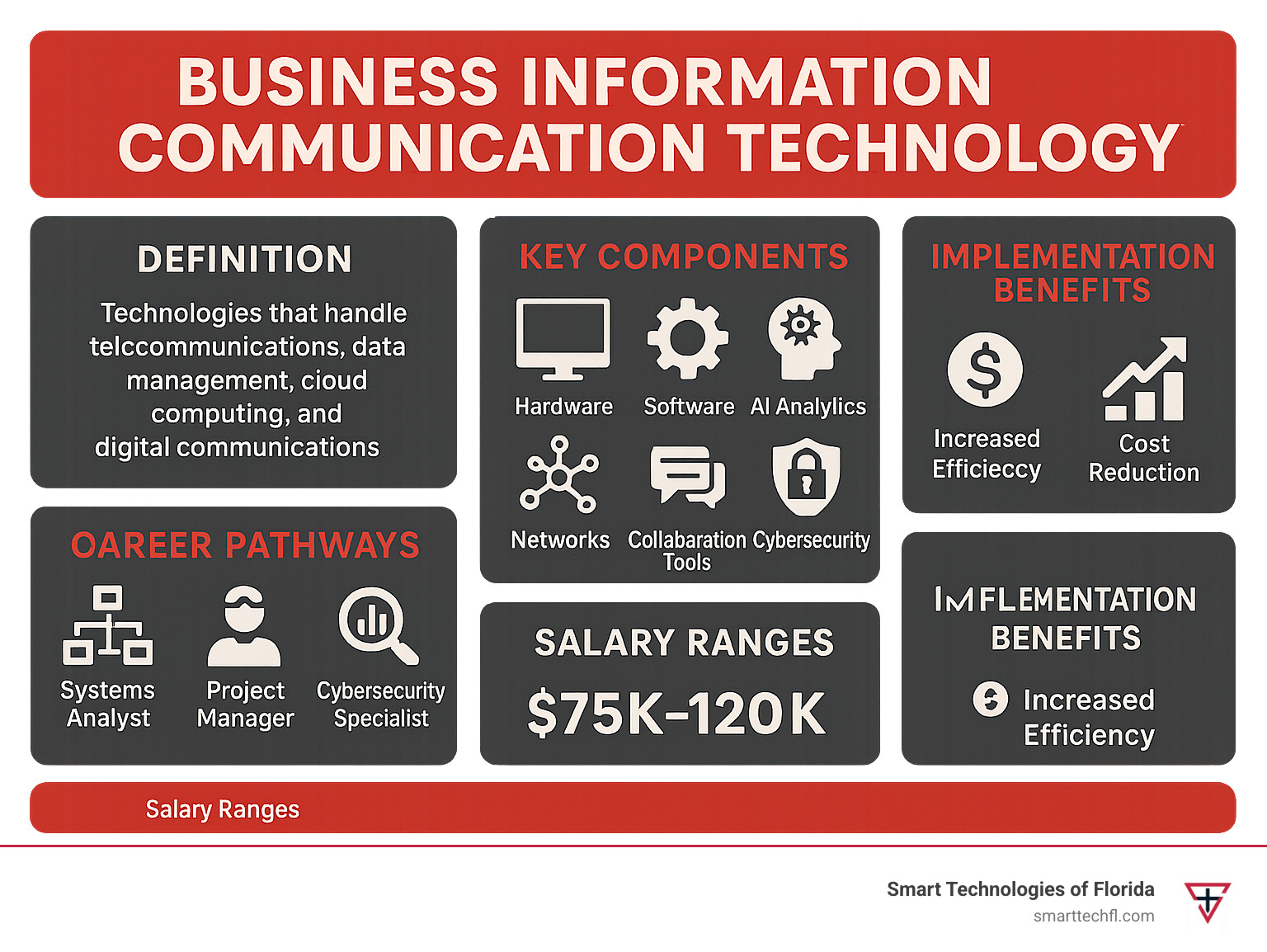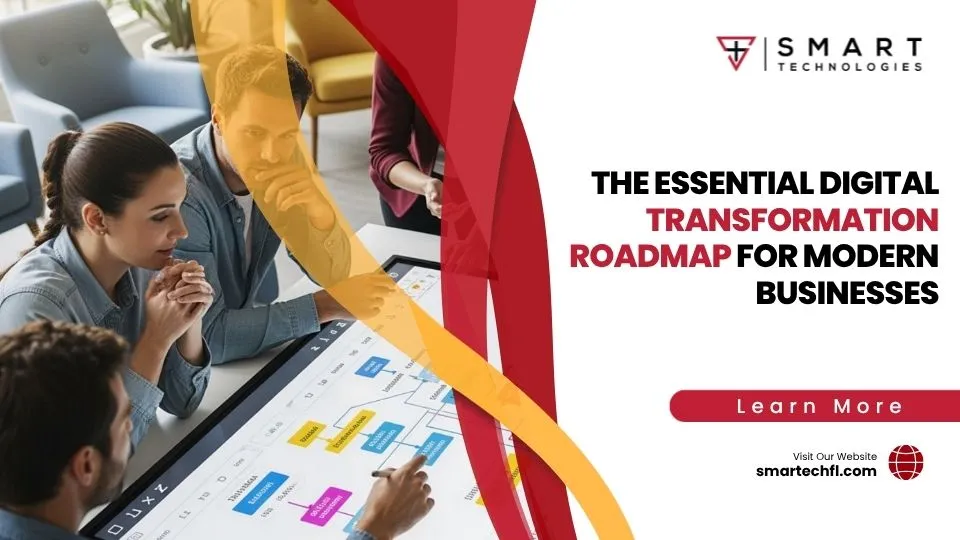Why Business Information Communication Technology is the Degree You Didn’t Know You Needed
Business information communication technology represents the backbone of modern digital operations, combining hardware, software, telecommunications, and data management systems to drive organizational success. Whether you’re looking to advance your career or transform your business operations, understanding ICT’s scope and impact is crucial in today’s digital-first economy.
Key aspects of Business Information Communication Technology:
- Definition: Technologies that handle telecommunications, data management, cloud computing, and digital communications
- Core Components: Hardware, software, networks, AI analytics, collaboration tools, and cybersecurity frameworks
- Business Applications: ERP systems, CRM platforms, e-commerce solutions, remote work tools, and automated processes
- Career Opportunities: Systems analysis, project management, cybersecurity, data science, and digital change roles
- Market Demand: 100% of graduates find employment or continue education within 6 months according to recent program data
The research shows that ICT has sparked the Fourth Industrial Revolution and fundamentally changed how businesses operate. Unlike traditional IT that focuses primarily on computing and networks, business ICT encompasses the full spectrum of communication technologies – from broadcast media to 5G connectivity to IoT sensors.
For business owners struggling with outdated systems and high operational costs, ICT offers a path to streamline processes, reduce expenses, and expand market reach. The technology enables everything from automated customer service through chatbots to global collaboration through unified communications platforms.
Recent studies indicate that companies leveraging ICT see significant improvements in efficiency, with some organizations reporting cost reductions of 30% and productivity gains of 50%. More importantly, ICT empowers rather than replaces human workers by automating routine tasks and providing better tools for decision-making.

What Is Business Information Communication Technology?
Think of business information communication technology as the digital nervous system of modern organizations. It’s the collection of tools, systems, and technologies that help businesses share information, connect with customers, and collaborate across distances.
While traditional IT focuses mainly on computers and software, business ICT takes a much broader view. It includes everything from your smartphone and video calls to cloud storage and smart building systems. The key difference? ICT is all about communication – helping people connect and share information effectively.
Scientific research on ICT scope shows that ICT fundamentally changes how we handle information through digital technologies. This means everything from old-school landline phones and radio broadcasts to cutting-edge AI and quantum computing falls under the ICT umbrella. It’s a big tent that covers any technology designed to help us communicate better.
At Smart Technologies of Florida, we’ve seen how business information communication technology serves as the foundation that makes modern computing and communication possible. It’s the technological backbone that lets businesses collect, process, and share information through computer systems and the internet.
| Aspect | Traditional IT | Business ICT |
|---|---|---|
| Focus | Computing, software, networks | All communication technologies |
| Scope | Hardware and software management | Telecommunications, broadcast media, IoT |
| Purpose | Information processing | Communication and collaboration |
| Components | Computers, servers, databases | Plus: mobile devices, VoIP, social media |
| Approach | Technology-centered | Human-centered communication |
Core Components of Business Information Communication Technology
Every effective business ICT system builds on six essential pieces that work together like a well-orchestrated team.
Computing devices and hardware form the physical foundation. This includes everything you’d expect – smartphones, tablets, laptops, and servers – plus specialized equipment like IoT sensors that can monitor everything from room temperature to inventory levels. These devices are the hands and eyes of your ICT system.
Cloud services and software applications provide the brain power. Modern businesses rely on cloud-based tools that let teams access powerful applications from anywhere. Think CRM systems that track customer relationships, ERP platforms that manage operations, and collaboration tools that keep remote teams connected.
Networks and connectivity act as the circulatory system, moving information where it needs to go. This includes internet infrastructure, 5G networks, and private organizational networks that ensure data flows smoothly and securely between all your devices and applications.
AI and analytics capabilities are becoming the smart decision-makers of ICT systems. Artificial intelligence now helps with everything from managing network traffic to providing customer service through chatbots. AI makes ICT systems faster, more efficient, and increasingly automated.
Collaboration and communication tools are where the magic happens for most users. Email, instant messaging, video conferencing, and unified communications platforms break down barriers between team members, customers, and partners regardless of where they’re located.
Cybersecurity frameworks serve as the immune system, protecting everything else. This includes encryption, access controls, threat detection, and disaster recovery systems that keep organizational data safe and ensure business continues even when problems arise.
Business ICT vs Traditional IT: Key Differences
The biggest difference between business ICT and traditional IT comes down to perspective and scope. Traditional IT manages the technical stuff – computers, software, and networks that process information. Business information communication technology takes a people-first approach that includes all communication technologies and emphasizes how humans actually use these tools.
Business ICT covers ground that traditional IT typically doesn’t touch. This includes broadcast media systems, telecommunications equipment, and audiovisual processing that helps organizations communicate more effectively. It’s this broader scope that makes ICT particularly valuable for companies looking to improve how they connect with customers and collaborate internally.
The communication focus means ICT systems are designed with human interaction at their core. Instead of just crunching data, these systems facilitate knowledge sharing, enable seamless remote collaboration, and support decision-making processes that involve multiple people and departments.
Modern business ICT also accepts emerging technologies like 5G connectivity, IoT sensors, and AI-driven analytics that extend far beyond traditional computing boundaries. This integration opens up new business opportunities, streamlines operations, and creates competitive advantages that simply weren’t possible with older IT approaches.
More info about Business Communication Solutions
Why a Degree in Business Information Communication Technology Matters in 2025
Here’s something that might surprise you: 100% of graduates from business information technology programs are employed or continuing education within six months of graduation. That’s not a typo – it’s a complete employment rate that reflects just how desperately companies need skilled professionals who can bridge the gap between technology and business operations.

The digital change that swept through businesses in recent years has fundamentally changed the job market. Companies that once operated with basic technology now need sophisticated digital systems just to keep their doors open. This shift has created a skills gap that’s actually good news for anyone considering a career in ICT.
The financial rewards are equally impressive. IT infrastructure managers earn an average of $108,000 per year, and that’s just the starting point. Specialized roles in cybersecurity, data analytics, and digital change command even higher salaries. More importantly, these aren’t just well-paying jobs – they’re future-proof careers in an economy that’s becoming more digital every day.
What makes business information communication technology careers particularly attractive is their scope. You’re not stuck fixing computers or troubleshooting software issues. Instead, you become a strategic advisor who helps organizations leverage technology to achieve their business goals. You lead change initiatives, design better customer experiences, and develop innovative solutions that directly impact revenue growth.
Business Information Communication Technology Degree = Career Catalyst
A degree in business information communication technology is like having a master key that opens doors across multiple industries and career paths. Unlike narrow technical specializations that box you into one type of work, ICT education prepares you for leadership roles that require both technological savvy and business sense.
Project management becomes a natural fit when you understand both the technical complexities and business objectives of digital initiatives. Whether it’s implementing new software, upgrading infrastructure, or rolling out remote work capabilities, organizations need leaders who can speak both languages fluently.
Systems analysis and design roles are perfect for ICT graduates because they require someone who can look at business processes with fresh eyes and identify where technology can make things better. You become the translator between what the business needs and what technology can deliver.
The cybersecurity field is practically begging for professionals who understand that security isn’t just about firewalls and passwords – it’s about business risk management. ICT graduates can explain security requirements in terms that executives understand and develop protection strategies that actually work in real business environments.
Data science and analytics opportunities are exploding as companies drown in information but starve for insights. ICT graduates understand both the technical aspects of managing data and the business context needed to turn numbers into actionable intelligence.
Perhaps most importantly, the shift to remote work has created entirely new career opportunities for professionals who can design and manage distributed collaboration systems. ICT graduates understand the full spectrum of technologies needed to keep virtual teams productive and connected.
Key Benefits for Organizations Hiring ICT Graduates
When organizations hire ICT graduates, they’re not just filling technical positions – they’re bringing in professionals who understand technology as a business enabler rather than just a necessary expense. The research backs this up with some impressive numbers.
Efficiency gains are often the most immediate benefit. ICT-trained professionals can spot opportunities to automate routine tasks, eliminate manual errors, and streamline processes that have been done the same way for years. Organizations report productivity improvements of up to 50% when ICT initiatives are properly implemented.
The innovation culture that ICT graduates bring is equally valuable. They’re trained to think creatively about technology applications and can help organizations develop new products, services, and business models that weren’t possible before. This fresh perspective often leads to breakthrough solutions that give companies significant competitive advantages.
Global reach becomes realistic when you have professionals who understand how to leverage ICT for international expansion. They know how to support remote teams, collaborate with overseas partners, and reach customers in new markets without the traditional barriers of distance and time zones.
Risk mitigation is another critical benefit. Modern businesses face numerous technology-related threats, from cybersecurity attacks to system failures that can shut down operations. ICT graduates can develop comprehensive strategies that protect organizational assets while still enabling the business to operate efficiently.
The impact on customer experience can be changeal. ICT systems enable personalized interactions, faster service delivery, and seamless multichannel communication. ICT graduates can design and implement systems that significantly improve customer satisfaction and loyalty, directly impacting the bottom line.
Scientific research on e-business empowerment confirms that organizations using ICT strategically gain significant competitive advantages through improved operational efficiency and improved customer engagement capabilities. The evidence is clear: investing in ICT talent pays dividends that extend far beyond the technology department.
Real-World Applications & Success Stories
When you look at how business information communication technology works in the real world, the results are pretty amazing. Companies across every industry are using ICT to solve problems, make better decisions, and find new ways to grow their business.

Think about how your favorite online store seems to know exactly what you want to buy. That’s ERP and CRM integration at work. These systems connect all the pieces of a business – from inventory and sales to customer service and accounting. When everything talks to each other, companies can see what’s happening in real-time and make smarter decisions.
E-commerce platforms have completely changed how we shop, but they’re just the tip of the iceberg. Behind every online purchase is a complex system of payment processing, inventory management, and personalized marketing. ICT makes it all work seamlessly, from the moment you click “add to cart” to when your package arrives at your door.
The healthcare industry has acceptd telemedicine in ways nobody expected just a few years ago. Doctors can now see patients remotely, access medical records instantly, and even use AI to help with diagnoses. This technology has made healthcare more accessible while keeping costs down and improving patient outcomes.
Supply chain tracking might sound boring, but it’s fascinating when you see it in action. Companies use IoT sensors and smart communication systems to follow products from the factory floor to your front door. When supply chains get disrupted, these systems help businesses adapt quickly and keep things moving.
The shift to remote work has made collaboration tools essential for businesses everywhere. Video calls, shared documents, and project management platforms let teams work together no matter where they are. It’s not just about convenience – it’s opened up new possibilities for how companies operate and grow.
Smart manufacturing is where ICT really shows its power. Factory machines now talk to each other, sharing data about production quality, equipment health, and efficiency. This creates what experts call Industry 4.0 – manufacturing that’s smarter, faster, and more flexible than ever before.
Modern businesses also rely heavily on chatbots and automated customer service to handle routine questions and tasks. This frees up human employees to focus on more complex problems while ensuring customers get help whenever they need it.
Case Study Snapshots
One online retailer transformed their business using retail personalization technology. By analyzing how customers browse and shop, they created a system that suggests products in real-time. The results were impressive – sales went up 35% and customers were much happier with their shopping experience.
A financial services company tackled their paperwork problem with fintech automation. They used ICT to handle routine banking tasks automatically, cutting processing time from hours to just minutes. This helped them serve more customers while reducing costs and improving service quality.
In healthcare, one organization implemented data verification systems that caught errors before they became problems. The automated system saved them over $1 million per year while improving patient care quality. It’s a perfect example of how ICT can improve both efficiency and safety.
A corporate office building became much smarter using IoT sensors and facility management systems. The building now monitors its own energy use, tracks equipment performance, and adjusts comfort levels automatically. Energy costs dropped 25% while employees became more satisfied with their work environment.
Customer service got a major upgrade at one company through AI sentiment analysis. The system monitors customer communications and flags potential problems before they escalate. This proactive approach has improved customer retention and helped resolve issues faster.
These success stories show how business information communication technology creates real value for organizations. Whether it’s saving money, improving customer experience, or enabling new ways of working, ICT delivers results that make a difference.
More info about Unified Communications in Business Success
Future Trends & Frequently Asked Questions
The future of business information communication technology is evolving at breakneck speed, and honestly, it’s pretty exciting to see where we’re headed. These emerging trends aren’t just cool tech concepts – they’re reshaping how businesses operate and compete in ways we couldn’t imagine just a few years ago.

AI-driven network management is becoming the brain behind modern ICT systems. Instead of waiting for something to break, AI now predicts network failures before they happen. It automatically adjusts performance and spots security threats in real-time. This means less downtime and fewer middle-of-the-night emergency calls for IT teams.
The buzz around quantum computing might sound like science fiction, but it’s becoming real for businesses. While we’re still in early stages, companies are exploring how quantum systems can solve complex problems that would take traditional computers years to figure out. Think advanced encryption and data analysis that makes today’s fastest systems look slow.
Edge computing and IoT expansion are changing where and how we process information. Instead of sending everything to distant data centers, smart devices now handle data right where it’s created. This means faster responses and opens up possibilities for everything from smart factories to connected healthcare devices.
Looking ahead, 6G networks will make today’s fast internet feel like dial-up. These ultra-fast connections will power augmented reality experiences, self-driving systems, and IoT applications we haven’t even dreamed up yet.
Sustainable ICT practices are becoming essential, not optional. Companies are investing in energy-efficient data centers and carbon-neutral cloud services. It’s good for the planet and often saves money too – a win-win situation.
The metaverse and virtual workspaces represent the next chapter in remote collaboration. Virtual reality meetings and immersive training programs are moving from novelty to necessity. Companies are finding that virtual environments can actually improve teamwork and learning outcomes.
What makes this exciting is the focus on lifelong upskilling. The technology landscape changes so quickly that continuous learning has become part of the job. This creates opportunities for people willing to grow with the technology.
How does business information communication technology empower global expansion?
Business information communication technology breaks down the walls that used to limit where companies could do business. Cross-border e-commerce platforms let small businesses sell worldwide without opening physical stores in every country. It’s democratizing global commerce in ways we’ve never seen before.
Multilingual communication systems and automated translation tools help companies serve customers who speak different languages. These aren’t perfect yet, but they’re getting remarkably good at helping businesses communicate across language barriers.
The real game-changer is remote workforce capabilities. Companies can now hire the best talent from anywhere in the world. Video conferencing, collaboration platforms, and project management systems make it possible for teams spread across continents to work together seamlessly.
Cloud-based ICT systems provide the flexibility to scale operations quickly in new markets. Instead of building expensive infrastructure in every location, companies can deploy systems rapidly and adjust capacity based on actual demand.
What challenges & risks come with ICT adoption?
Let’s be honest – with great technology comes great responsibility, and some serious challenges too.
Cybersecurity threats are probably the biggest headache for businesses today. Every new connection creates another potential entry point for hackers. Companies need comprehensive security measures including encryption, access controls, and 24/7 threat monitoring. It’s like having a really sophisticated security system for your digital assets.
Privacy compliance gets tricky when you’re dealing with customers from different countries. GDPR in Europe, HIPAA in healthcare, and dozens of other regulations each have their own requirements. Getting this wrong can result in hefty fines and damaged reputation.
Integration complexity is another real challenge. Most businesses use multiple ICT systems that need to talk to each other. When they don’t communicate well, you end up with data trapped in silos and frustrated employees trying to work around the technology instead of with it.
The skills shortage is perhaps the most persistent challenge. Technology evolves faster than people can learn it, creating ongoing gaps in expertise. Organizations need to invest heavily in training and development to keep their teams current.
How can companies measure ROI on ICT initiatives?
Measuring the return on ICT investments doesn’t have to be complicated, but it does require looking at multiple angles.
Productivity metrics provide the clearest picture of ICT impact. Companies can track how much faster tasks get completed, how error rates decrease, and how overall output improves. These numbers usually tell a compelling story about technology’s value.
Cost savings analysis focuses on direct reductions in expenses. This includes savings from automation, reduced manual labor, and improved efficiency. These are often the easiest benefits to calculate and present to leadership.
Revenue impact measures how ICT enables new business opportunities. This might include new products made possible by technology, improved customer experiences that increase sales, or expanded market reach through digital channels.
Innovation metrics track how ICT investments lead to new ideas and improvements. Companies can count new products, services, or process improvements that technology made possible.
Customer satisfaction scores reveal how ICT improvements affect the customer experience. Better response times, improved service quality, and improved interaction capabilities usually translate to happier customers and better retention rates.
The key is choosing metrics that align with your specific business goals and tracking them consistently over time. This creates a clear picture of how ICT investments contribute to overall business success.
Conclusion
Here’s what we know for certain: business information communication technology isn’t just another career option – it’s your ticket to a future-proof profession that’s actually in demand. With every single graduate finding work or continuing their education within six months, you’re looking at some of the best job security available today.
The numbers don’t lie. Strong salaries, diverse opportunities, and the chance to work in virtually any industry you find interesting. But here’s the real kicker – ICT graduates don’t just get jobs, they get meaningful careers where they solve real problems and help organizations thrive.
For business owners, hiring ICT graduates means bringing in people who speak both languages fluently: technology and business. These professionals understand that fancy gadgets mean nothing if they don’t help real people do their jobs better or serve customers more effectively.
At Smart Technologies of Florida, we’ve watched this change unfold over our 23 years in business change. The most successful organizations aren’t the ones with the fanciest technology – they’re the ones that combine smart ICT solutions with a people-centric approach that keeps human needs at the center of every decision.
The digital revolution keeps rolling forward, creating new opportunities faster than most people can keep up. The companies that will lead tomorrow are building their ICT capabilities today. They’re investing in professionals who can steer both the technical complexity and the human side of organizational change.
Whether you’re planning your next career move or figuring out how to give your organization a competitive edge, business information communication technology expertise isn’t optional anymore – it’s essential. The only question is whether you’re ready to step into the opportunities that are waiting for you.
The future is digital, connected, and full of possibilities. And it definitely needs people who understand how to make technology work for everyone.












